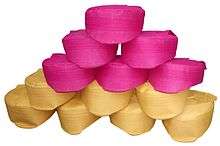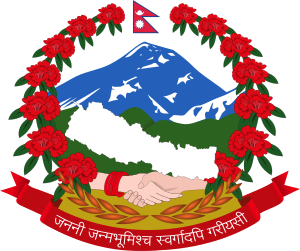Maithils
Maithils (Tirhuta: মৈথিল, Devanagari: मैथिल), also known as Maithili people, are an Indo-Aryan ethno-linguistic group from the Indian subcontinent, who speak the Maithili language as their native language. They inhabit the Mithila region,[5] which comprises Tirhut, Darbhanga, Kosi, Purnia, Munger, Bhagalpur and Santhal Pargana divisions[lower-alpha 1] of India[6][7] and some adjoining districts of Nepal.[8] The Maithil homeland forms an important part of Hindu mythology as it is said to be the birthplace of Sita, the wife of Ram.[9]
| Total population | |
|---|---|
| c. 43 million | |
| Regions with significant populations | |
| India | 40 million (2001 Census)[1][2] |
| Nepal | 3.1 million (2011 Census)[3] |
| Languages | |
| Maithili, Hindi.[4] | |
| Religion | |
| Majority:
Minority: | |
| Related ethnic groups | |
| Magahi people · Bhojpuris · Awadhis | |
History
Vedic period
Mithila first gained prominence after being settled by Indo-Aryan speaking peoples who established the Videha kingdom. During the late Vedic period (c. 1100-500 BCE), Videha became one of the major political and cultural centers of South Asia, along with Kuru and Pañcāla. The kings of the Videha Kingdom were called Janakas.[10]
The Videha Kingdom later became incorporated into the Vajji confederacy which was based in Mithila.[11]
Medieval period
From the 11th century to the 20th century, Mithila was ruled by various indigenous dynasties. The first of these were the Karnatas, who were of Parmar Rajput origin, the Oiniwar dynasty, who were Maithil Brahmins, and the Khandavalas of Raj Darbhanga, who were also Maithil Brahmins.[12] It was during this period that the capital of Mithila was shifted to Darbhanga.[13][14]
Region
India
Majority of Maithils normally reside north of the Ganges; based around Darbhanga and the rest of North Bihar. [15] Native Maithili speakers also reside in Delhi, Kolkata, Patna, Ranchi and Mumbai.[16]
Indian Mithila comprises Tirhut, Darbhanga, Kosi, Purnia, Munger, Bhagalpur and Santhal Pargana divisions.[17]
Darbhanga in particular played an important role in the history of Mithila and is considered one of its "core centers". It was the center of Raj Darbhanga who ruled most of the region.[18] Madhubani was also where Madhubani paintings originated from which is a major part of Maithil culture.[19] Sitamarhi is claimed by many to be the birthplace of Goddess Sita with Sitakund being a major pilgrimage site. Baliraajgadh, situated in present-day Madhubani district, is thought to be the capital of ancient Mithila Kingdom.[20] Maithils played a major role in building the Baidyanath Temple which is an important pilgrimage site for them.[21] There is an ongoing movement in the Maithili speaking region of Bihar and Jharkhand for a separate Indian state of Mithila. A likely candidate for the capital of the proposed state is Darbhanga, while other potential sites include Muzaffarpur, Purnia, and Begusarai.[22]
Nepal
Most of the region from Jhapa to Parsa in Nepal (centered around Janakpur, in southeastern Nepal) form Nepalese Mithila. This area was part of the kingdom of Videha.[23] The kingdom appears in the Ramayana. Many people claim Janakpur to be the birthplace of Goddess Sita but this is disputed as many consider Sitamarhi as Her birthplace. Maithils in Nepal have been working towards a "Free Maithil state".[24]
There is a movement in the Maithili speaking areas of Nepal for a separate province.[25] Province No. 2 was established under the 2015 Constitution, which transformed Nepal into a Federal Democratic Republic, with a total of 7 provinces. Province No. 2 has a Maithili speaking majority and consists most of the Maithili speaking areas of Nepal. It has been demanded by some Mithila activists that Province No. 2 be named 'Mithila Province'.[26]
Ethnicities and castes
Many ethnic groups and castes inhabit the Mithila region, these include Maithil Brahmins, Rajputs, Bhumihars, Karan Kayasthas, Ahirs, Kurmis, Koeris, Baniyas and many more.[27]
Maithil Brahmins are the Hindu Brahmin community of the Mithila region. They are one of the five Pancha-Gauda Brahmin communities.[28] They are also noted for panjis, the extensive genealogical records maintained for the last twenty-four generations.
Rajputs are scattered throughout the region and are divided into various sub-clans with the most prominent being the Gandhawarias who ruled estates mainly in Saharsa and Madhepura.[29] The Rajputs of Mithila maintain social and marital relations with Rajputs of other regions.
Language
The common language of Maithil people is Maithili, which is one of the recognised regional languages of India and the second national language of Nepal listed in the Eighth Schedule of the Indian Constitution and the Interim Constitution of Nepal. It is an ancient language, from which Nepali, Bengali and related scripts have evolved. The oldest example of this Mithilakshar or Tirhuta script is a Shiva temple inscription in Tilkeshwarsthāna (near Kusheshwarsthāna, in Darbhangā district), in which it is mentioned in Eastern Māgadhi Prākrit that the temple was built on "Kāttika sudi" (Kārtika Shukla pratipadā, or the first tithi in the bright half of the Hindu lunar month of Kārtika) in "Shake 125" (AD 203) on the day after Diwāli (still regarded as auspicious for installing an icon in a temple). The script of the inscription is little different from modern Maithili script. However, during the 20th century most Maithili writers gradually adopted Devanagari script for Maithili.[30] Some traditional pandits still use Tirhutā or Mithilākshara script for pātā (ceremonial letters related to important functions, such as marriage). Fonts for this script were developed in 2003.
Culture

The most striking aspects of their environment are the decorated rice containers, colorfully painted verandahs and outer walls of their homes using only available materials like clay, mud, dung and grass. Much of the rich design is rooted in devotional activities and passed on from one generation to the next, occasionally introducing contemporary elements such as a bus or an airplane.[31]
Household structure
Traditionally Maithils lived in Badaghars called longhouses with big families of many generations, sometimes 40–50 people. All household members pool their labor force, contribute their income, share the expenditure and use one kitchen.[32]
Cross-border regionalism
Mithila regionalism unites Maithils of India and Maithils of Nepal from both sides of international border. Since they share a common history, language, culture, and ethnicity, they feel part of one Mithila. Positive events on one side of the international border are celebrated on the other side, and negative events are mourned on both sides.[34]
Notable people
- Harisimhadeva - King of Mithila during the Karnata dynasty.
- King Janaka – king of the Videha kingdom
- Sita – wife of the Hindu figure Ram
- Vidyapati - Maithili poet and a Sanskrit writer
- Kirti Azad - former Indian cricketer and politician from Darbhanga
- Bindhyabasini Devi - folk singer
- Kranti Prakash Jha - Bollywood actor and model
- Narendra Jha – Bollywood actor
- Sriti Jha – Bollywood actor
- Bhavna Kanth - One of the first female pilots of India
- Kanhaiya Kumar, Indian politician
- Udit Narayan – Bollywood playback singer
- Pravesh Mallick – Bollywood music director
- Sanjay Mishra – Bollywood actor
- Kameshwar Singh Bahadur - the last zamindar of Raj Darbhanga in India
- Sharda Sinha - Maithili folk singer
- Jyotirishwar Thakur – Maithili poet and writer
- Gangesha Upadhyaya - 12th-century Indian mathematician and philosopher
- Ram Baran Yadav - former president of Nepal
See also
- History of Mithila Region
- Culture of Mithila Region
References
Notes
- Santhal Pargana division is headquartered at Dumka and the cited source mentions the division as "Dumka division"
- "Kirti Azad demands a separate Mithila state". m.indiatoday.in. Retrieved 14 February 2017.
- Dr. Arun C. Mehta. "District-wise Population (Census) Data: 2001 Census, India". Educationforallinindia.com. Archived from the original on 17 September 2009. Retrieved 18 July 2013.
- Dr. Arun C. Mehta. "Maithil Population (Nepali Census) Data: 2011 Census, Nepal". Educationforallnepal.com. Archived from the original on 17 September 2009. Retrieved 18 July 2013.
- "Demographics of Maithil population of Nepal".
- Burman, B.K.R.; Chakrabarti, S.B. (1988). Social Science and Social Concern: Felicitation Volume in Honour of Professor B.K. Roy Burman. Mittal Publications. p. 411. ISBN 9788170990628. Retrieved 14 February 2017.
- Jha, Pankaj Kumar (2010). Sushasan Ke Aaine Mein Naya Bihar. Bihar (India): Prabhat Prakashan.
- "The Politics of India Since Independence". p. 184. Retrieved 15 February 2017.
- Gellner, D.; Pfaff-Czarnecka, J.; Whelpton, J. (2012). Nationalism and Ethnicity in a Hindu Kingdom: The Politics and Culture of Contemporary Nepal. Taylor & Francis. p. 251. ISBN 9781136649561. Retrieved 14 February 2017.
- Minahan, J.B. (2012). Ethnic Groups of South Asia and the Pacific: An Encyclopedia: An Encyclopedia. ABC-CLIO. ISBN 9781598846607. Retrieved 14 February 2017.
- Michael Witzel (1989), Tracing the Vedic dialects in Dialectes dans les litteratures Indo-Aryennes ed. Caillat, Paris, pages 13, 141–143
- Raychaudhuri Hemchandra (1972), Political History of Ancient India, Calcutta: University of Calcutta, pp. 85–86
- "Anthropology of Ancient Hindu Kingdoms: A Study in Civilizational Perspective". Retrieved 11 December 2016.
- "Wetlands management in North Bihar". Retrieved 14 December 2016.
- "Anthropology of Ancient Hindu Kingdoms: A Study in Civilizational Perspective". Retrieved 14 December 2016.
- "Bihar district gazetteers, Volume 17". p. 16. Retrieved 10 December 2016.
- Maithils at Ethnologue (16th ed., 2009)
- Jha, Pankaj Kumar (2010). Sushasan Ke Aaine Mein Naya Bihar. Bihar (India): Prabhat Prakashan.
- "Anthropology of Ancient Hindu Kingdoms: A Study in Civilizational Perspective". p. 62. Retrieved 10 December 2016.
- "Madhubani paintings". Retrieved 10 December 2016.
- "नालंदा ने आनंदित किया लेकिन मिथिला के बलिराजगढ़ की कौन सुध लेगा ? - News of Bihar". NewsOfBihar.com. 16 July 2016. Archived from the original on 26 October 2017. Retrieved 26 October 2017.
- Narayan, Sachindra (1 June 1983). "Sacred Complexes of Deoghar and Rajgir". Concept Publishing Company – via Google Books.
- "Small States Syndrome in India". p. 146. Archived from the original on 17 February 2017. Retrieved 16 February 2017.
- Michael Witzel (1989), Tracing the Vedic dialects in Dialectes dans les litteratures Indo-Aryennes ed. Caillat, Paris, pages 13, 17 116–124, 141–143
- "Nationalism and Ethnicity in a Hindu Kingdom". Retrieved 8 December 2016.
- Burkert, C. (2012). "Defining Maithil Identity". In Gellner, D.; Pfaff-Czarnecka, J.; Whelpton, J. (eds.). Nationalism and Ethnicity in a Hindu Kingdom: The Politics and Culture of Contemporary Nepal. London, New York: Routledge. pp. 241–273. ISBN 9781136649561. Archived from the original on 20 August 2017.
- http://kathmandupost.ekantipur.com/printedition/news/2018-05-02/samiti-vows-to-protest-for-mithila-province.html
- "Anthropology of Ancient Hindu Kingdoms: A Study in Civilizational Perspective". pp. 32–35. Retrieved 6 February 2017.
- Venkatesa Iyengar (1932). The Mysore of Brahmins of Mithila region of Nepal. Mittal Publications. p. 301. GGKEY:XFC5XHQ9E3J.
- "The Journal of the Bihar Purāvid Parishad, Volumes 7-8". pp. 412–415. Retrieved 6 February 2017.
- Chaudhary, Pranava (May 22, 2011). "US scholar's project of encoding Tirhuta script into digital media". The Times of India. Bennett, Coleman & Co. Ltd. Retrieved 26 July 2013.
- Meyer, K. W., Deuel, P. (1997). "The Maithils of the Terai-Madhesh". Indigo Gallery, Kathmandu. Retrieved 7 December 2006.CS1 maint: multiple names: authors list (link)
- Lam, L. M. (2009). "Park, hill migration and changes in household livelihood systems of Maithils in Central Nepal" (PDF). University of Adelaide. Archived from the original (PDF) on 2011-09-28.
- "A History of Indian Logic: Ancient, Mediaeval and Modern Schools". Retrieved 8 December 2016.
- "Maithils of India mourned for Maithils of Nepal who losts lives in Janakpur bombing 9205721". Jagran.com. 2 May 2012. Retrieved 22 September 2013.
Bibliography
- Alan R. Beals & John Thayer Hitchcock (1960). "Field Guide to India". India: National Academies.
